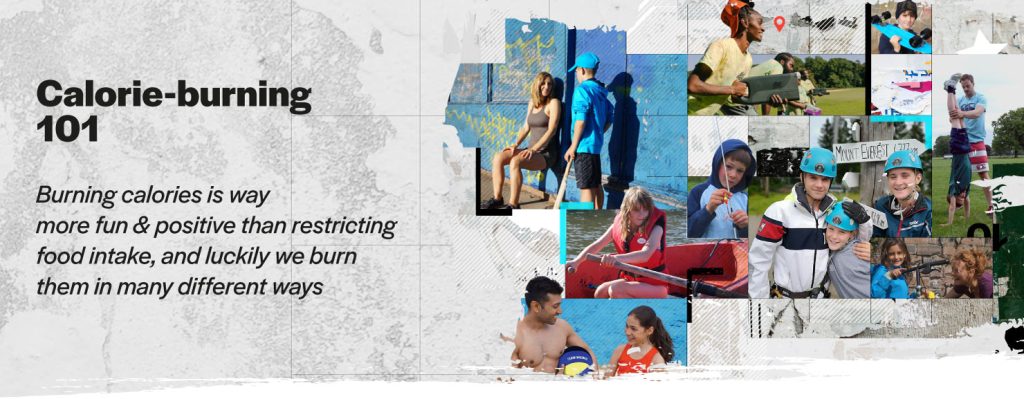Have you ever been in a gym, full of energy and good intentions, started on the treadmill and after 40 minutes of sweat and hard work you look at the screen and… you only burned 250 Cal…. Wait, what?!? That doesn’t even make up for the half sandwich you had before the workout! So which one is it, do you need to be constantly training or do you need to monitor your food like a freak?
Luckily it’s neither! First, let’s get familiar with the terms!
History and facts about calories
One calorie was originally defined as the work necessary to push 1 Newton through 1 meter. I admit that’s not a nifty way to memorise it unless you’re sitting physics exams this year…. A calorie is really just an energy unit, applicable to anything that generates energy: could be electricity, fire, or food. It’s actually tiny, so the useful way to measure is Cals or Kcals – 1000 times greater. In your everyday life, there are three macronutrients in our food: 1 gramme of protein provides 4 Calories, 1 gramme of carbohydrates provides 4 Calories and 1 gramme of fat provides 9. Burning calories is way more fun and positive than restricting food intake, and luckily we burn them in many different ways!
Humans and calories
Our body needs a constant flow of fuel to keep balanced and functioning. This state is “homeostasis” and it guarantees that your tissues are renewed, wounds repaired, glucose is sluiced through to your brain and your muscles are maintained.
We get heavier or lighter, not necessarily fatter or slimmer, based on our calorie balance. If we onboard more calories than we burn, we gain weight and vice-versa. There is no exception to this. It doesn’t matter what you eat, if you consume even more you will lose weight. However, we shouldn’t confuse weight loss with overall health, being toned, strong and athletic.
Let’s dissect the different ways those calories are used.
Breaking down calorie-burning
Basal Metabolic Rate (BMR): This basically refers to all the energy that you need to simply stay alive! The younger and heavier you are, the more you consume. We humans are “endothermic” animals, or warm-blooded. Keeping the body temperature around 37°C takes up to 16% of the daily expenditure of an active person! If you add into the equation cerebral activity, tissue regeneration, digestion (it’s hard work!), respiration, heartbeats, kidney function and all the other background activities, we reach a whopping 65-70% of the whole daily calorie expenditure. *
Growth and Puberty: For a human, the long stage of “growth” lasts for about 18-20 years. This hugely increases the demand for energy in our bodies. Bones, organs, muscles constantly adapt to the changing size. It is a costly process, a risky evolutionary tradeoff. Poor nutrition in your childhood or puberty might impair your growth rate, just as much as sedentary habits. So we need to keep a couple of elements in mind.
During puberty your hormonal levels literally crave physical activity. Muscles want to grow, bones must get stronger, and your brain is avidly looking for new things to learn. Just give in to this, be active! Learn, play, fall, run… and repeat!**
Second, we need to keep in mind that this won’t last forever. Calorie demands drop drastically between 22-28 years, so you need to adapt as I outline below, or face some chubby 30th birthday selfies.
Everyday life activities (or NEAT): Every sort of mild to moderate effort that is not classifiable as exercise goes under the acronym of NEAT (non-exercise activity thermogenesis). If you walk your dog, cycle to school, help your parents around the house, play the drums or bring your skateboard to the park, it all helps. Trying new or old sports for fun can also be classified as NEAT. A laid-back pick-up game with friends, football or basketball, can help you get rid of 150-200 calories. In general NEAT activities can add up to 350 calories a day to your energy expenditure. Not a huge amount but vital to play an active role in reducing the risk of obesity, cardiovascular diseases and diabetes.***
Sport and Fitness: This is the game changer. And body changer. While everyday life tasks can make you burn some extra calories and keep major diseases at bay, sport and fitness will mould your body into something completely different.
- Calories burnt during activity (thermogenic effect): the intensity and effort produced when competing in sports or training seriously is in a completely different league from everyday activities. A game of basketball can burn up to 800 Cals. An intense swimming training session for an hour (on and off, not constant) up to 1000. If you are a good runner, 1 hour of 8mph run can go up to 1100! Naturally, you have to build up to such intensity and duration, you don’t just wake up one day and play a competitive game of basketball.
- E.P.O.C. effect: this interesting reaction of our metabolism is often neglected. Intense activities trigger higher metabolic demand for a long time after you have finished. EPOC stands for Excess Post-exercise Oxygen Consumption. Your body uses more oxygen than normal, thereby burning fat, to try to restore the normal energy balance after a very hard session. If you really push hard, the effect can last for 12 hours! This adds a truckload of calories to your BMR, increasing it with 10-15% for this window of time, making you burn more even while at rest.****
- Body composition change: the ultimate sport effect. When our body undertakes powerful efforts by activating big muscle groups, hypertrophy is triggered (muscle growth). When we’re repeatedly sprinting, lifting, jumping very high or performing complex movements, we recruit our muscles to achieve extraordinary results. Here is where the magic happens. Remember the BMR? Pure, lean muscle mass increases your metabolic rate enormously. If you have more muscles, you burn more calories just by having them. Not exercising them, just to maintain them at rest. And it’s not a negligible amount. Research shows that just for semi-professional athletes, all the most common equations to calculate BMR greatly underestimate their calorie needs.***** They are like a furnace of energy when they are at rest, all thanks to your improved body composition.
You might have a passion for a certain sport, or maybe you love a specific look – the powerful sprinter or elegant long distance runner. Whatever you love, you will mould your body to an extent. Long distance cardio training doesn’t recompose your muscles like explosive training. While running for an hour straight has the highest thermogenic effect, it doesn’t really build much lean mass (muscles). You only burn calories in the moment. For a long lasting, real body transformation, it is strength you are looking for.****
Not all activities are good
Many activities are refreshing, stimulating, enjoyable but they don’t all help you expend energy beyond the BMR. Reading, playing video games, scrolling on your phone, going on a car trip do not activate your metabolism in a significant way. Standing is already a little better: it burns about 50-60 calories per hour more than sitting. Still, not a huge amount…. You could have used that hour to help your mother assemble an IKEA sofa or tidy up your room for a huge 160 calories….
Are you saying I can tuck in then?
The calories that you see on the treadmill screen are (very approximately) the calories that you burnt by doing that workout, not the only ones you burnt during the day. Calories are not the problem! Just take care that it’s overall nutritious food, and that you stay active routinely. On top of that, make sure the pedal hits the metal with regular intense workouts as well. For optimal results, throw in strength work. Embrace the extra fatigue. Sports may injure, but sofas kill (unless you assembled it).
References
*Jagim, A., R., Camic, C., L., Kisiolek., J., Luedke, J., Erickson, J., Jones, M. T., Oliver, J., M. (2018) ‘Accuracy of resting metabolic rate prediction equations in athletes.’ Journal of Strength and Conditioning research, 32(7), 1875-1881.
**Soliman, A., De Sanctis, V., Elalaily, R. (2014) ‘Nutrition and pubertal development.’, Indian journal of endocrinological metabolism, 18(1), 39-47.
***Chung, N., Park, M., Kim, J., Park, H., Hwang, H., Lee, C., Han, J., So, J., Park, J., Lim, K. (2018) ‘Non-exercise activity thermogenesis (NEAT): a component of total daily energy expenditure.’ Journal of exercises nutrition biochemistry, 22(2), 23-30.
****Greer, B. K., O’Brien, J., Hornbuckle, L. M., Panton, L. B: (2021) ‘EPOC comparison between resistance training and high-intensity interval training in aerobically fit women.’, International -Journal of exercise science, 14(2), 1027-1035.
****Stavres, J. R., Zeigler, M. P., Bayles, M. P. (2018) ‘Six weeks of moderate functional resistance training increases basal metabolic rate in sedentary adult women.’ International Journal of exercise science, 11(2), 32-41.
Further reading – just for fun
https://www.t-nation.com/training/train-like-a-man#.UFfThTpMjFR.facebook






